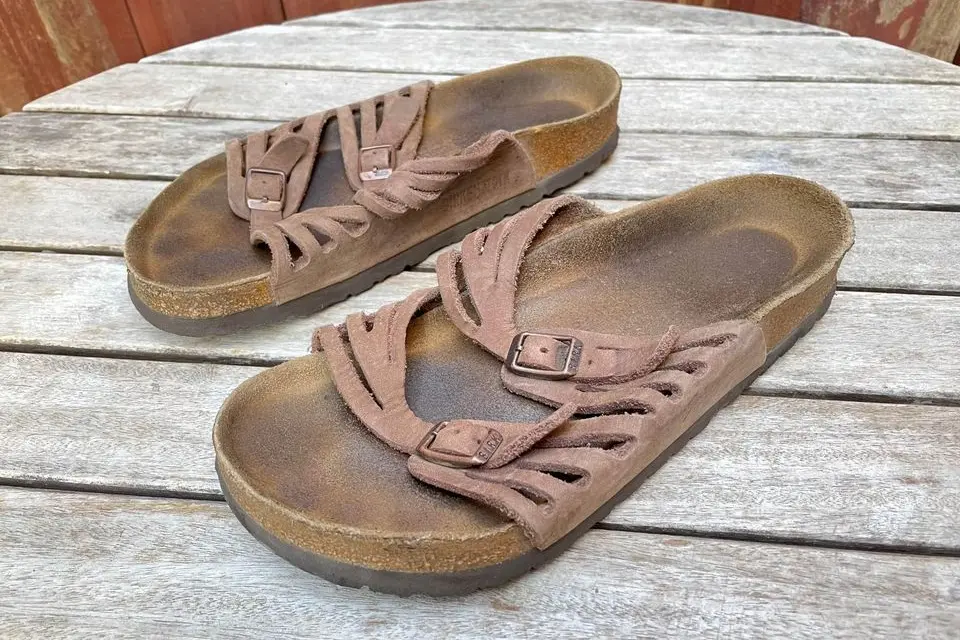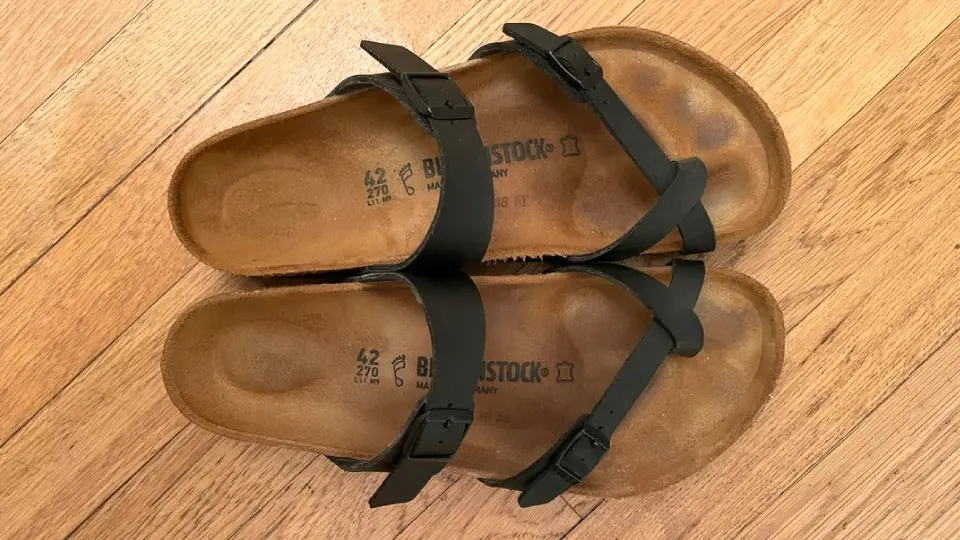How to Remove Heel, Toe & Foot Marks from Leather Sandals
Nothing can affect the appearance of your leather sandals like unpleasant foot, heel, and toe marks on the insoles (they look like footprints). They can make you self-conscious when you take your leather sandals off at the beach or by the pool, making them look worn and dirty.
Although it may look like discolored leather to some, the footmarks on your leather sandals are just embedded dirt. How deeply the dirt is trapped in your leather sandals’ soles can be determined by the type of insole.
The different types of insoles or footbed materials used for leather sandals are usually leather, suede, cork, or vinyl. You’re also recommended to use different cleaning methods, depending on the insole material.
This guide will teach you how to remove heel, foot, and toe marks from leather sandals for all types of insole materials. Although it may seem like a daunting task, you will be able to remove all those unsightly marks using the methods that we’ll go through below.
Why Do Leather Sandals Show Heel, Toe & Footmarks?
With longer use, leather sandals adapt to the shape of your feet. This also applies to the insoles and with constant pressure on the same areas, you’ll be able to see an imprint of your foot on the insoles.

After some time, your insoles begin to absorb moisture and dirt from your feet’s soles. This is a common cause of unappealing heel, toe, and footmarks on your leather sandals that can ruin their look and make them look worn and dirty.
These marks often appear if you wear your leather sandals regularly (twice or thrice per week) without cleaning them. Since sandals are mostly worn in the summer months, sweat can also make your sandals’ soles appear dirty.
You’ll see footmarks on your leather sandals form faster in humid and damp environments, as moisture mixed with dirt permeate through your insoles. Leather and suede insoles are particularly affected, as they are porous and sensitive materials.
Additionally, leather sandals are often open, unlike leather boots or shoes, which allow dust and dirt to get trapped in the insole more easily. Another reason why footmarks are common on leather sandals is that many people do not wear socks with them.
While wearing socks with sandals can help absorb sweat from your feet and keep them away from the soles (preventing footmarks), it’s often frowned upon – unless you don’t mind a visit from the fashion police.
Removing Heel, Toe & Foot Marks from Leather Sandals
Leather sandals often have soles or footbeds made of different materials. Regardless of your leather sandals’ brand or style, we will cover cleaning all footbed materials in this guide.
Take note that you will only be able to avail the best result if you treat the footmarks of your leather sandals according to the material of the insoles. Let’s get started!
Removing Foot Marks from Suede Insoles
Suede leather insoles are typically found on premium or more expensive leather sandals, such as Birkenstock. Suede is a soft leather material that is difficult to protect against the elements and clean since it easily absorbs dust and dirt.
Hence, if you have leather sandals with suede insoles, you will be able to notice the formation of footmarks (especially toe and heel marks) visibly since it’s so sensitive. Removing them from leather sandals can be tricky, but if you follow the steps below, you’ll be fine!
You must use a specified suede cleaner, such as the Sof Sole Suede and Nubuck Leather Shoe Cleaner or anything similar to get the dirt out to remove the visible footmarks. You can also use a solution of diluted vinegar (1 cup white vinegar with 2 cups of water) to clean footmarks from suede leather soles.
Spray the cleaning solution on the footbed and use a rag or toothbrush to gently rub the dirt layer off. Ensure to clear the surface with a clean towel to bring back the neat suede skin after cleaning.
Removing Foot Marks from Leather Insoles
To remove any footmarks from leather insoles, you can use saddle soap or any dedicated leather cleaning product to get this done. Apply saddle soap onto the leather footbed with a damp cloth and rub in small circular motions to get the dirt and grime out.
This will clean the footmarks on your leather insoles and even help remove any unpleasant smells from them. If you would like to understand more about cleaning leather insoles, feel free to read our guide on cleaning leather sandals.
Removing Foot Marks from Cork Insoles
Many leather sandals have cork insoles. Cleaning footmarks from cork insoles is quite straightforward and can be achieved with the use of saddle soap or a general cleaner.
Cork is the outer layer of bark tissue and is known for its durable and long-lasting properties. Insoles made of cork are made to last and don’t typically show footmarks easily.
You will need to apply a cleaning solution or saddle soap on the footbed of the leather sandals with a damp cloth. Use circular motions and gentle pressure to get the embedded dirt out of your cork insoles.
Since cork is not a sensitive material, it can withstand more wear and tear. As a trade-off, however, it doesn’t give a comfortable and premium feel similar to leather or suede insoles.
Removing Foot Marks from Vinyl Insoles
Some non-premium leather sandals have a vinyl footbed, and only the upper and strap is made of leather. You can use any general leather cleaner to clean the vinyl footbed. You should apply some of the product onto the footbed and remove the dirt using a clean cloth.
Since vinyl is a more robust and less sensitive material, it can withstand more pressure and harsher cleaning materials. However, we do not recommend that you use a detergent. Instead, opt for a gentle soap – you can never go wrong with saddle soap.
While vinyl insoles on leather sandals are easily replaceable and washable, they don’t offer the same comfort as a leather or suede footbed.
How to Prevent Heel, Toe & Foot Marks from Forming
The formation of footmarks on your leather sandals is a natural and inevitable process, which cannot be prevented indefinitely. However, you can slow down the process and protect your leather sandals for more durable wear.
Below, you’ll find some of the best practices on footmark prevention for leather sandals.
- Clean Your Leather Sandals Regularly – It’s best to clean your leather sandals once or twice a week. This will ensure dirt does not penetrate the leather pores of the insoles and also keeps your leather sandals looking clean and neat. Be careful while cleaning suede since frequent or improper cleaning can harden the material, altering its appearance and texture.
- Store Your Leather Sandals Appropriately – Ensure that you store your sandals away from moisture and humidity. If your leather sandals have absorbed sweat from your feet, you should allow to dry them since moist leather absorbs dirt more easily.
- Protect Your Leather Sandals – Regularly apply leather care products, polishes, and conditioners to keep the leather footbed clean, supple, and shiny. Conditioning produces adds a protective layer to your leather sandals, keeping dirt off the insoles so that footmarks don’t form easily. It also makes them easier to clean.
- Replace Leather Insoles – If the insoles of your leather sandals have heel, toe, and footmarks and are worn out, you can replace the leather insoles entirely. However, this may depend on the type of your leather sandals and the manufacturer.
In summary, footmarks are natural and form with frequent use of your leather sandals. There are various ways to remove these footmarks and you should also treat them according to the material they’re made of.
In order to slow down the process of footmark formation, make sure that you clean the insoles regularly and replace them when needed and if possible. We hope this guide was helpful to you.

About Gerrit
Co-Founder, Researcher & Writer At Leatherskill
I’m a leather enthusiast who spends most of his free time crafting, researching, and writing about the many facets of this versatile material. Thanks for reading!

